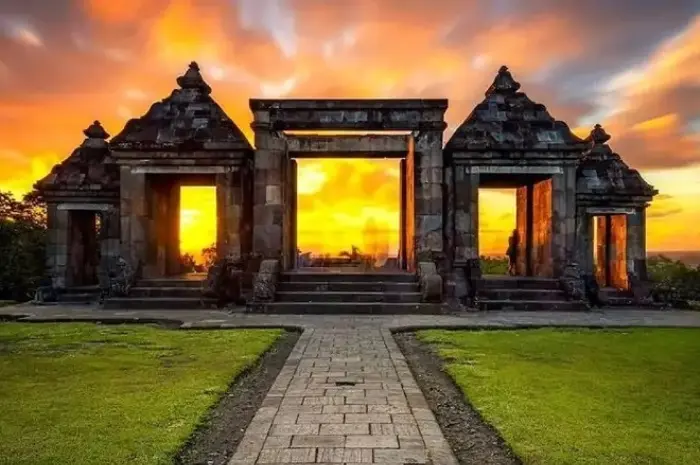Ratu Boko Temple, perched majestically in the Sleman district of Yogyakarta, Indonesia, is an archaeological site of immense historical and cultural significance.
This ancient temple complex, often overshadowed by the nearby famous temples of Prambanan and Borobudur, holds its own as a remarkable and exotic tourist attraction.
In this extensive article, we explore Ratu Boko Temple in depth, covering its rich history, architectural splendor, cultural significance, and its allure as a must-visit destination in Jogja.
Historical Background
Ratu Boko Temple is believed to date back to the 8th century, during the era of the Sailendra Dynasty, which also constructed the world-renowned Borobudur Temple. The site is named after King Boko, a legendary figure in Javanese folklore. While often referred to as a temple, Ratu Boko is more accurately described as a palace complex, with its vast array of secular buildings and structures.
Over the centuries, Ratu Boko has undergone various phases of construction and renovation, evidenced by the diverse architectural styles present in the complex. The site was rediscovered in the 19th century and has since been the subject of numerous archaeological studies.
Architectural Features
Ratu Boko Temple showcases a unique blend of Hindu and Buddhist architectural elements, reflecting the religious pluralism of ancient Java. The complex spans an impressive area and includes various structures such as gates, bathing places, temples, and pavilions.
One of the most striking features of Ratu Boko is its grand entrance gate, which is adorned with intricately carved reliefs. The complex also boasts a well-preserved crematorium, a structure rare in Javanese temple architecture.
The palace area features remnants of what were once luxurious dwellings and audience halls. These ruins offer a glimpse into the opulence and sophistication of the Javanese courts during the 8th century.
Cultural Significance
Ratu Boko Temple holds immense cultural significance as it provides insights into the social, religious, and political aspects of ancient Javanese civilization. The site is a testament to the advanced architectural and cultural achievements of the Sailendra Dynasty.
The complex is not only significant for its historical value but also for its role in the study of Javanese history and archaeology. It continues to be a site of scholarly research, contributing to our understanding of ancient Java’s history and culture.
Panoramic Views and Natural Surroundings
Situated on a plateau, Ratu Boko Temple offers stunning panoramic views of the surrounding countryside, including a clear view of the Prambanan temple complex and Mount Merapi in the distance. The natural setting of the site, amidst lush green fields and hills, adds to its exotic charm and appeal.
A Tourist Destination
Today, Ratu Boko Temple is a popular destination for tourists visiting Yogyakarta. Visitors are captivated by the site’s historical significance, architectural beauty, and the serene ambiance it offers. The complex is particularly popular at sunset when the fading light bathes the ruins in a golden hue, creating a mystical and enchanting atmosphere.
Recreational Activities
Apart from exploring the historical ruins, visitors to Ratu Boko can enjoy various recreational activities. The complex is an ideal spot for photography, offering numerous opportunities to capture the stunning architecture and scenic landscapes. Cultural events and traditional performances are occasionally held at the site, providing visitors with a richer experience of Javanese culture.
Preservation and Conservation
Efforts are ongoing to preserve and conserve Ratu Boko Temple. The Indonesian government and cultural preservation bodies are working to maintain the integrity of the site and promote sustainable tourism practices. These efforts ensure that Ratu Boko continues to be a source of cultural pride and historical learning for future generations.
Conclusion
Ratu Boko Temple stands as a beacon of Indonesia’s rich historical and cultural heritage. Its unique blend of architectural styles, panoramic views, and historical depth make it a fascinating destination for anyone interested in exploring the ancient civilizations of Java. As a place where history is etched into every stone, Ratu Boko offers a captivating journey into the past, inviting visitors to immerse themselves
in the mysteries and wonders of a bygone era. Whether one is an archeology enthusiast, a lover of natural beauty, or simply a curious traveler, Ratu Boko Temple in Sleman, Jogja, presents an experience that is both enlightening and enchanting.
As you wander through the remnants of the palace grounds, you can envision the grandeur of the ancient Javanese court, where kings and queens once walked. The site is a silent witness to centuries of history, standing resilient against the test of time.
Educational and Spiritual Aspects
For students and researchers, Ratu Boko provides an invaluable educational resource. It serves as a live classroom for learning about ancient Javanese architecture, art, and society. The spiritual aura of the place, with its historical Buddhist and Hindu elements, also attracts those seeking a deeper understanding of these ancient religions and their coexistence.
Ecotourism and Community Involvement
In line with the principles of ecotourism, the local community plays an essential role in the upkeep and tourism activities of Ratu Boko. There is a concerted effort to ensure that the benefits of tourism are shared with the local population, providing them with sustainable livelihood opportunities while preserving their cultural heritage.
Conclusion
Ratu Boko Temple in Sleman, Jogja, is more than just an archaeological site; it is a symbol of Indonesia’s rich and diverse history, a testament to the architectural genius of ancient Java, and a serene sanctuary that offers a unique blend of cultural, educational, and spiritual experiences.
As a destination, it invites exploration and contemplation, offering visitors a chance to step back in time and experience the grandeur of an ancient civilization, all while surrounded by some of the most beautiful landscapes in Indonesia.







